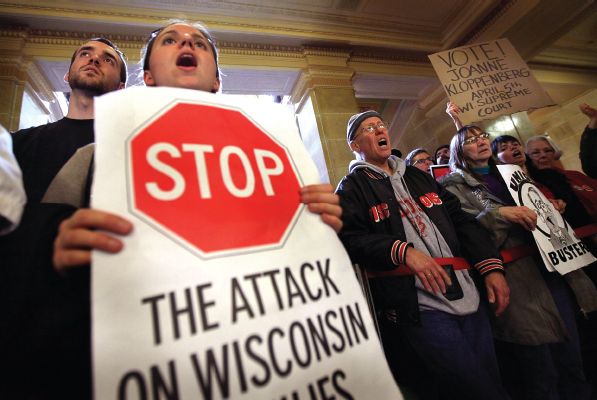Case Study
CASE STUDY
Labor Gets Framed
Labor union membership in the United States dropped from a high of 34.7 percent of the workforce in 1954 to about 11.8 percent (6.9 percent in the private sector) by 2012. In a world where economic and social forces increasingly separate the “haves” from the “have-nots” and popular media such as entertainment television and film rarely address labor issues, the news media remain one of the few places to find stories about the decline in labor unions and the working class.
Could the way in which news stories frame labor unions have an impact on how people in the United States understand them?
Analyzing the frames of news stories—that is, the ways in which journalists present them—is one form of textual analysis. Unfortunately, if one looks at how the news media frame their reports about labor unions, one has to conclude that news coverage of labor is not at all good.

In 2011, thousands of Wisconsin teachers staged “sickouts” to protest the passing of a bill that would take away public employees’ collective-bargaining rights.
In a major study,1 hundreds of network television news (ABC, CBS, and NBC) and national newspaper (New York Times and USA Today) reports involving labor over a ten-year period were analyzed to get a sense of how such stories are framed.
An interesting pattern emerged. Instead of discovering a straight-forward bias against labor, the study found that news stories frame labor in a way that selects the consumer perspective (as opposed to a citizen or worker perspective). That is, labor unions aren’t portrayed as inherently bad, but any kind of collective action by workers, communities, and even consumers that upsets the American consumer economy and its business leaders and entrepreneurs is framed as a bad thing.
The classic example is the strike story. Even though less than 2 percent of all contract negotiations result in strikes, news stories seem to show union members regularly wielding picket signs. The real stars of strike stories, though, are the inconvenienced consumers—sour-faced people who are livid about missed flights, late package delivery, or canceled ball games. And usually the reports don’t explain why a strike is occurring; viewers and readers mainly learn that the hallowed American consumer is upset and if those darned workers would just be a little more agreeable, then none of this inconvenience would have happened.
The frame carries an interesting underlying assumption: If collective action is bad, then economic intervention by citizens should happen only at the individual level (e.g., quit or “vote with your pocketbook” if you don’t like something). Of course, individual action would preempt collective action on the part of organizations such as labor unions, which, as organized groups, hold the promise of offering more democratic and broader solutions to problems that affect not one but many workers.
Corporate news that appears in many newspaper business sections frames labor stories in ways that are in harmony with the media corporations’ own economic priorities. But such stories need to do so without giving the appearance of bias, which would undermine their credibility. So they frame these stories from the perspective of the consumer. In recent years, in stories about government workers in states like Wisconsin, Ohio, and Michigan, the narratives are the same, and the consumer perspective becomes the taxpayer perspective.
With such framing, the news media’s stories undercut a legal institution—labor unions—that might serve as a useful remedy for millions of American workers who want independent representation in their workplace. In fact, national surveys have shown that the majority of American workers would like a stronger voice in their workplaces but have negative opinions about unions, so they aren’t likely to consider joining them.2
And that’s the disconnect that the framing study illustrates: People want independent workplace representation, but—according to the news—labor unions and similar forms of collective action are hardly a viable option.